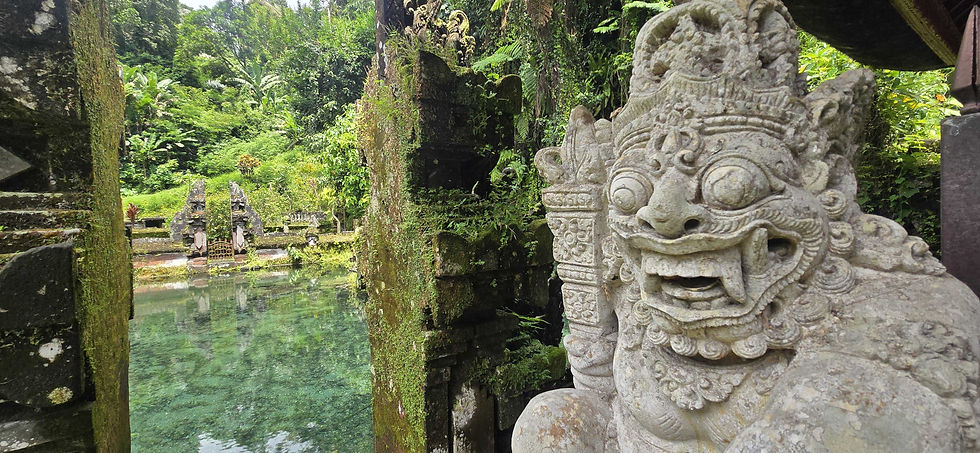Gunung Kawi Sebatu - Mayadenawa's Curse
- Shannon
- Sep 17
- 4 min read
Sacred Pools and Dark Legends in Sebatu Village
Gunung Kawi Sebatu is one of Bali’s lesser visited yet most serene temple complexes, nestled in the forested highlands of Sebatu village. Established during the 11th century, its origin is tied to the ruthless reign of King Mayadenawa, a figure known in Balinese lore for defying the gods. The temple is dedicated to Vishnu, the Hindu preserver deity and features crystal-clear spring pools, manicured gardens and a peaceful atmosphere that belies the legend tied to its sacred waters.

The name Sebatu comes from the Balinese words sauh (to slip) and batu (rock), a reference to the smooth, moss-covered stones worn down by centuries of flowing spring water. Beneath its calm exterior, Sebatu holds deep ritual importance. Balinese Hindus visit the temple to perform Melukat, a sacred cleansing rite believed to dissolve spiritual impurities and negative thoughts. The ceremony targets "klesa", mental afflictions like anger, fear and delusion, that are thought to poison the mind and disconnect the individual from divine balance.

According to Balinese legend, King Mayadenawa was a powerful ruler born in the green caldera of an exploded volcano, who descended from the powerful Daitya, a race of giant mythical demons . When he ascended the throne, he is said to have outlawed the worship of Hindu gods, declaring himself divine. He destroyed many shrines and temples and forbade the worship of God. His rule brought famine and illness to the island, a sign, according to oral tradition, that divine favour had been withdrawn. The story of Mayadenawa reaches its climax when the god Indra led a celestial force to confront him. In an act of sabotage, Mayadenawa manifested a vast spring of poisonous water near Indra's encampment. Many soldiers fell ill after drinking from it. To counter the poison, Indra pierced the ground with his staff, causing a pure spring to erupt and this is the origin story attributed to the sacred waters of Sebatu.

Mayadenawa, realising his powers were no match for Indra’s divine army, retreated into the dense Balinese jungle. According to legend, he used powerful black magic to shapeshift repeatedly, assuming the forms of animals, spirits and natural elements in a desperate attempt to avoid capture. Each transformation brought him closer to exhaustion. As the pursuit continued through thick forests and ravines, Mayadenawa finally collapsed and transformed into a large stone, hoping to disappear into the landscape itself.

Beneath the tranquil waters of Gunung Kawi Sebatu - Mayadenawa's Curse is a legacy shadowed by darkness
But the gods had not been deceived. Indra, guided by divine insight, discovered the unnatural stillness of the rock. Blood began to ooze from its surface, an omen that confirmed Mayadenawa's presence. In response, Indra loosed a sacred arrow into the heart of the stone. From the wound, blood poured forth in a torrent, forming what would become the Petanu River. For another thousand years, Balinese belief held that the river was cursed. It was said that any rice grown with its waters would carry misfortune and kings who bathed in it would face downfall. Even today, remnants of this belief persist in ceremonial practices and local oral tradition, reminding villagers of the cost of hubris and the enduring reach of divine justice.

Today, the temple’s spring fed pools continue to play a vital role in the spiritual lives of local communities and is an active temple to the Balinese people . Pilgrims come to bathe in the sacred waters, participating in time honoured rituals meant to purify the body and restore inner harmony. The legend of Mayadenawa is still recited during major Balinese festivals, not merely as myth, but as a warning against spiritual corruption and the consequences of defying the divine. It also stands as a testament to the enduring belief that Bali’s landscapes are not just beautiful but alive with sacred force.

🗺️ Location
Pura Gunung Kawi Sebatu, Sebatu Village, Tegallalang, Gianyar Regency, Bali, Indonesia
🚆 How to get there
This temple is located about 14km's or roughly 35 minutes drive north of Ubud. If you’re not riding a scooter, hiring a private driver is a great option and will cost around 600,000 IDR, with a visit to Gunung Kawi Sebatu bundled into a full day itinerary with other nearby sites like the Tegallalang Rice Terraces, Ulu Petanu Waterfall and the sacred Tirta Empul Temple. Alternatively, a Go-Jek rider will typically cost around 250,000 IDR for a half day loop, depending on your route. Just be mindful that this temple is often mistaken for the nearby Gunung Kawi Tampaksiring Temple, which is more crowded and very different. To avoid confusion, have a screenshot or pinned map location of Gunung Kawi Sebatu ready before you go.
⭐ Attraction Info
The temple is open to visitors daily from 8am to 6pm, with an entrance fee of 50,000 IDR per person for a self guided tour. The entry fee also includes the hire of a sarong and sash. Around 45 minutes to an hour is ample time to explore the grounds at a relaxed pace. If you’re looking for a deeper experience, you can book a Melukat purification ceremony combined with a guided temple tour, typically costing around 450,000 IDR for 4 - 6 hours.
🔗Official Website

Thanks for reading about Gunung Kawi Sebatu - Mayadenawa's Curse. Check out more awesome destinations here!

Canang Sari is daily offering the Balinese craft as a form of gratitude to the Gods who have blessed their lives



















































